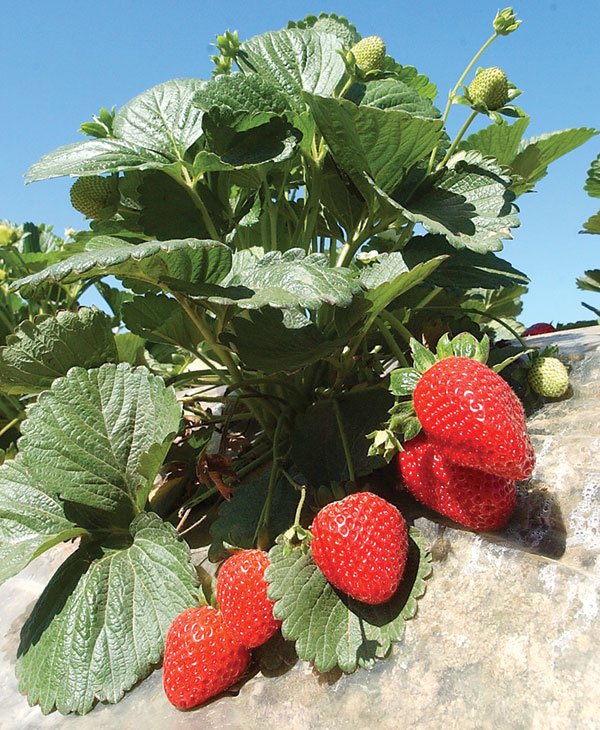The delicate strawberry is a South Valley fixture in the warm
spring and summer months, but its past stretches well beyond the
area. It’s a member of the Fragaria family, which also claims the
rose as a member of its family tree.
The delicate strawberry is a South Valley fixture in the warm spring and summer months, but its past stretches well beyond the area. It’s a member of the Fragaria family, which also claims the rose as a member of its family tree.
Like roses, strawberries come in a vast number of varieties, from the European everbearing, a strawberry plant that was cultivated on and off in pre-Christian Europe and has been popularly grown since the 15th century, to the common strawberry that shoppers are likely to find in their local Safeway, according to the Web site Encyclopedia.com.
Common strawberries, as we know them today, are actually the hybridization of two North American breeds – one originating in Eastern North America and another indigenous to Chile and parts of Western North America.
Carried home by early European explorers, the plants were thinly dispersed in the Old World, but became a heavily cultivated crop since they reproduce more readily than the indigenous European variety.
In fact, the site noted that the entire French strawberry industry grew from a single North American plant.
The perfumed fruit took on a lore of its own once it was introduced to Europe.
The new plant produced larger, more tart berries and its fruit was hardier than the European variety.
Luscious berries were considered high-quality aphrodisiacs in provincial France, where newlyweds were served a traditional soup of thinned sour cream, strawberries and sugar seasoned with borage, an herb that tastes similar to cucumber.
In Victorian times, the fruit was listed in the language of flowers as a symbol of absolute perfection, according to the California Strawberry Commission.
And strawberries still garner aphrodisiac status, with many hotels offering newlyweds or romantic couples a snack of strawberries and champagne with which to toast their night together.
At-home growers won’t be cultivating strawberries in the sophisticated fashion of professional farmers, but a taking a few notes from the pros isn’t a bad idea, according to Susan Bell, a master gardener with the Santa Clara County Master Gardeners who has been growing her own berries for more than 30 years.
“You want to make sure your berries are protected, because strawberries get some really funky, weird diseases,” said Bell. “I find they really grow best when you pull runners (the reproductive offspring of a mature strawberry plant) off the mother plant when they start getting little nubby roots. You can pot them where they’re just hanging over the air or near a rock wall or the edge of a walk, so they have something to lay on other than the soil.”
If none of those locations is convenient, Bell has discovered a trick of her own.
“I know it sounds silly, but I take the grass after my husband has mowed the yard, and I kind of tuck it under the plants like a little pillow,” said Bell. “It dries out and looks kind of like hay, which is what farmers used to use to keep the berries from touching the ground before the plastic sheeting.”
In professional growth, strawberries are an extremely labor-intensive crop. Planted and picked by hand, the delicate plants are prone to a host of soil-borne diseases and pest issues, but they also require intensive care and significant capital investment.
Sowing and caring for one acre with an average of 26,000 plants costs between $10,000 and $12,000, said Tim Chiala, director of produce sales and marketing for George Chiala Farms.
This year, more than 32,000 acres of the berries will be planted in California, producing nearly 90 percent of the country’s fresh and frozen strawberries and supplying the sun-ripened fruit to countries like Canada, Mexico, the United Kingdom, Hong Kong and Japan, according to industry group the California Strawberry Commission.
At a road-side stand on Masten Avenue, row upon row of perfectly sweet, tantalizingly fragrant strawberries sit stacked on the produce shed’s display shelf, their deep red color pulling drivers off of the road and away from their regular view of brown fields.
A bitter wind disturbs the dirt parking lot around the shed, but still travelers continue to stop on their way home from work, trading crisp dollar bills for the weighty yellow flats filled with baskets of the juicy fruit.
Today has been all right, says Chiala, but more people will need to stop if he’s going to break even this season. Strawberries are delicate, fickle plants, and Mother Nature hasn’t been kind to local farmers this season.
A long rainy season and low temperatures have combined to thwart the growing process and damage the berries that do hang from Chiala’s plants, bruising and mildewing many of them before they can ever be picked or sold.
“I should be picking about 400 boxes a day,” said Chiala, gesturing to a tightly packed flat containing 12 green plastic baskets of berries. “Right now, I’m picking about 80.”
Even for home growers who are not practicing the monoculture common to large farms, the plants are so prone to disease that Bell recommends uprooting mother plants on a yearly basis, allowing their offspring to stay in the planting bed.
To keep the garden looking neat, however, she recommends simply training all of the plants in one direction.
“One year you can train all your runners to the right, and the next you can put them all to the left,” said Bell. That’s better for the soil since they tend to harbor things.”
One of the most common maladies afflicting berries that consumers will be able to spot is a tendency called “cat-facing,” which affects the shape and growth of the berry.
Small mites bite the surface of the fruit, deforming it as it grows. When this happens, the berry comes to a rounded point with whisker-like folds emanating from the tip. A perfect berry, said Chiala, should have a broad, smooth, wedge-shaped base.
The Chiala crew, led by farm manager Ian Teresi, began planting in preparation for this year’s harvest back in late October, tilling the field and shaping it into neat rows 60 inches across, separated by shallow runoff troughs.
The berries would be planted on this space later on, but there was much work to be done before then.
Farmers begin preparing the soil by laying drip lines for fertigation, a combination of fertilizer and water delivered under the soil at the plant’s root level, and tarping the ground with plastic.
This provides a shield against weeds and extra water, since berries are sensitive to soil richness and moisture.
“They like a lot of water, but they don’t like to be wet,” said Chiala, who recommended well-drained soil for home growers. “The plastic also helps to keep them warm, since they’re pretty sensitive about temperature, and it keeps them from sitting directly on the ground where they get wet, and they mold.”
Why do produce stand berries seem to taste better than store-bought?
The delectable taste of berries from a local produce stand is more than a sentimental reaction to the fruit and the warm, sunny days that accompany its sale. Strawberries that are sold in produce stands are almost always picked fresh the day of sale, said Tim Chiala, director of produce sales and marketing for George Chiala Farms. Unlike store-bought berries, which are picked green to extend their shelf life, produce stand berries are allowed to mature on the vine, significantly raising their sugar concentration, which gives them that wonderfully sweet taste.
The best way to store your strawberries, Chiala recommends, is to remove them from the basket and place them in a Tupperware-type container. Line the bottom of the container with a paper towel to absorb extra moisture and do not wash berries until you are ready to use them, he cautioned.
To achieve maximum freshness, the California Strawberry Commission recommends layering several paper towels in the container to keep berries from touching one another. This will inhibit the growth of anything unsightly like mold or mildew.














